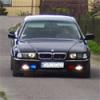Verdict
 http://www.autocarma...0-Sport/226578/
http://www.autocarma...0-Sport/226578/This is a better Bravo than the pre-production launch cars we sampled earlier in 2007. It feels better built and more refined, gelling more effectively than those early examples, and the 148bhp T-Jet engine offers real performance and bang for your buck. It can be vocal, but keen drivers will be happy with the trade-off, especially as it delivers the promised fuel economy and CO2 emission improvements.
This car also scores with its styling, price, an attractive interior and decent equipment. But the Bravo is a car you must try before you buy, because the driving position may prove uncomfortable. Less serious, but annoying, is the difficulty of reading the instruments.
The Bravo�s chassis is not as accomplished as the class best, but it�s better than many key rivals. In combination with its substantial appeal on other fronts, this Fiat deserves a far wider audience than its predecessors.
--
The Bravo unusual in this class for being handsome � svelte, even. In engineering terms it scores for being a front-runner with a downsized engine.
The new car is heavily based on the old Stilo � fortunately with significant refinements � but new are the downsized 1.4 petrol T-Jet engines, both fitted with turbochargers to improve efficiency and reduce emissions.
The base 89bhp 1.4 motor is a lightly modified edition of the long-lived FIRE engine, while the 1.4 T-Jet is an extensively reworked, turbocharged version producing either 118bhp or 148bhp, the downsizing process providing 10-20 per cent fuel economy and emissions improvements over comparable 1.6 and 2.0-litre engines. It�s the 150 T-Jet that we test. The diesel line-up consists of the familiar common-rail 1.9s of 118bhp and 148bhp, while all engines come with a six-speed gearbox bar the base diesel.
The Bravo�s suspension is a MacPherson strut front/twist beam rear axle set-up. It�s less sophisticated than the fully independent multi-link arrangements of the Ford Focus and VW Golf, but it has been extensively refined, with hydraulic rear axle anchorage bushes, for instance, and a variety of modifications intended to improve the front axle�s strength and precision.
The Bravo has achieved a five-star EuroNCAP occupant crash rating, though only two stars for pedestrian impact � and much attention has been paid to noise suppression.
You get a lot of go for your money with this T-Jet engine. You can pay as little as �13,995 for it, but even at the �14,295 that this Sport costs there�s little to touch it for the money in terms of horsepower or acceleration.
The 1.4-litre motor�s smaller-than-average turbo very effectively reduces lag, this engine feeling pretty feisty despite a little low-rev lethargy and a couple of flat spots under full throttle.
Sport versions of the 150 T-Jet get a shot of overboost torque, the 170lb ft total enough to propel the Fiat to 60mph in 8.5sec and on to 131mph. That acceleration is achieved through shorter gearing in the middle ratios and this, together with a relatively limited rev range (the red line is at 6000rpm, and the cut-out at 6500rpm) means more gearchanging than might be expected with so much torque.
When it comes to ride and handling, the Bravo hasn�t really got the sophistication of the class-leading Focus and Golf, or the solid capability of the Astra, but it is good enough. The first surprise is that despite its biggish wheels and low-profile tyres the Sport rides with a firm pliancy that feels quite sophisticated, even if sharp-edged potholes make the suspension crash.
Better still is that the Bravo�s bodyshell feels genuinely rigid, an impression underscored by a robustness that Fiats rarely display.
The story is similar in the handling department. Turn-in is quite sharp and the chassis pretty obedient up to a point, this being the moment when the engine�s enthusiasm gets the better of the tyres.
The steering is the weakest dynamic link. Fiat�s Dualdrive electric assistance is fitted; press the Sport button on the dash and the resistance is firmed below 19mph. But while the Bravo changes direction with fair accuracy, the sensation of mild woolliness never departs.
The brakes are a shade over-servoed at first, and they could use more bite once past that point.
Those used to the dull, fragile feeling of Fiats past will be agreeably surprised by the Bravo�s cabin, which is stylish, attractive and well made.
The main dash is dual-textured, the main occupant-facing section finished with a soft-feel faux carbonfibre material. The wheel is attractively leather-bound, the instruments look classy, the seat trim is attractive and the ambience lifted by tasteful flashes of chrome and piano black. If the lower reaches of the interior are lower grade, the overall effect is nevertheless pleasing and individual.
But while the Bravo�s cabin is spacious, your enjoyment of it may be compromised. The driving position does not suit all. Despite a four-way adjustable wheel, a seat height adjuster and an infinitely adjustable backrest, some testers found themselves endlessly adjusting each in a vain attempt to get comfortable, possibly because the classic Italian �short leg, long arm� stance is forced on you.
There�s disappointment in the rear, too. Under-thigh support is limited because the cushion is mounted too close to the floor, an upshot of the coup�-like roofline. Which is a shame, because knee and foot room aren�t bad, and the seat itself appears well shaped. Less of a compromise is the boot, which is big, well shaped, easy to get at and extendable by folding rear seats that hinge to form a protective bulkhead.
This car is excellent value and turns in better-than-average fuel economy. But depreciation, the bane of many a Fiat, may undermine it. On the positive side, the Bravo�s style and Fiat�s concerted attempts to improve a below-par dealer network should help, as will the evident improvement in quality. But against it is history, and fearsome competition. There�s nothing unusual about the Bravo�s back-up either, in contrast to the new 500 which can optionally be had with a five-year/300,000-mile warranty. Depreciation apart, though, the Bravo should prove painless to own.

























































